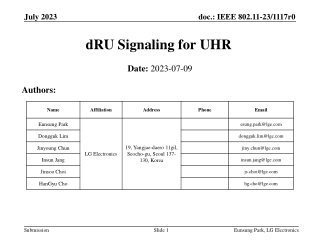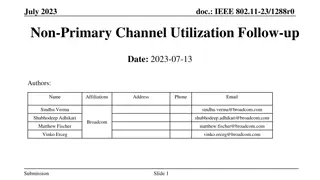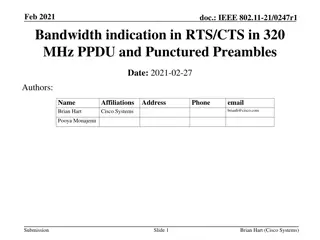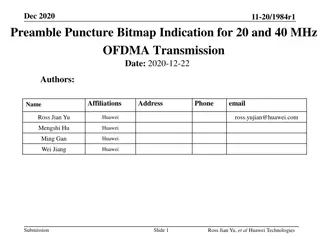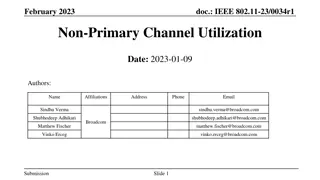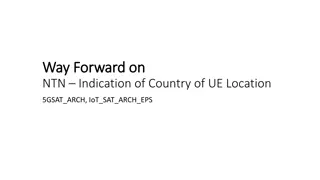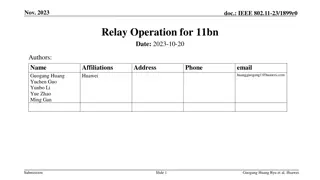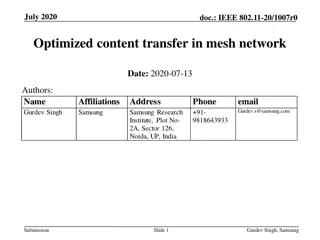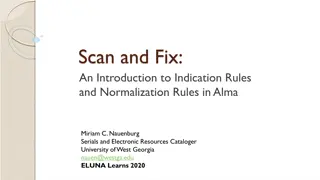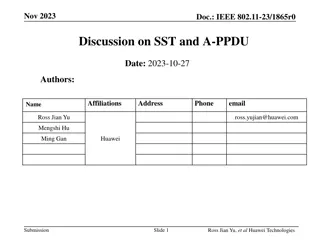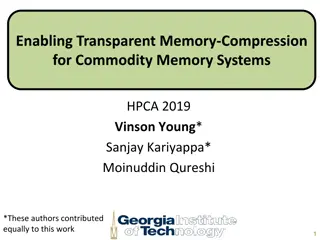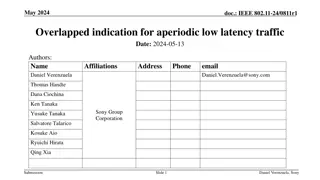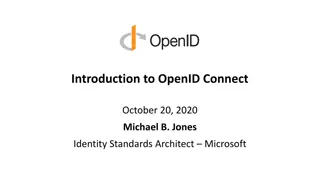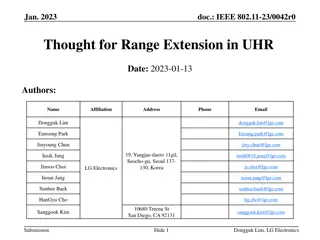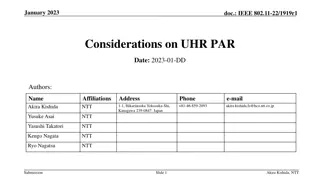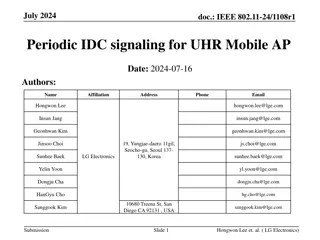Proposed Mechanism for UHR Operating Bandwidth Indication
The document proposes a mechanism for a UHR AP to indicate a nominal and expanded operating channel width, defining the BSS bandwidth for UHR features. It addresses scenarios where BSS bandwidth needs to be limited for specific purposes, offering a solution for effective bandwidth indication.
Download Presentation

Please find below an Image/Link to download the presentation.
The content on the website is provided AS IS for your information and personal use only. It may not be sold, licensed, or shared on other websites without obtaining consent from the author.If you encounter any issues during the download, it is possible that the publisher has removed the file from their server.
You are allowed to download the files provided on this website for personal or commercial use, subject to the condition that they are used lawfully. All files are the property of their respective owners.
The content on the website is provided AS IS for your information and personal use only. It may not be sold, licensed, or shared on other websites without obtaining consent from the author.
E N D
Presentation Transcript
August, 2024 doc.: IEEE 802.11-24/1116r0 Operating bandwidth indication for UHR Date: 2024-08-25 Authors: Name Vishnu V. Ratnam Affiliations Samsung Electronics Address Phone email vishnu.r@samsung.com Boon L. Ng Peshal Nayak Rubayet Shafin Yue Qi Bilal Sadiq Ravi Gidvani Samsung Michail Koundourakis Samsung Cambridge Solution Centre Submission Slide 1 Vishnu Ratnam, Samsung Electronics
August, 2024 doc.: IEEE 802.11-24/1116r0 Abstract This document proposes a mechanism for a UHR AP to indicate a nominal operating channel width and an expanded operating channel width in the UHR Operation element. The two channel widths jointly define the BSS bandwidth that can be used for different UHR features. Submission Slide 2 Vishnu Ratnam, Samsung Electronics
August, 2024 doc.: IEEE 802.11-24/1116r0 Operating bandwidth indication - Recap An AP indicates the BSS bandwidth that is applicable for transmission or reception in the BSS within the Operation element included in Beacon/Probe Response/Association Response frames. The indication is Wi-Fi generation dependent, and is carried in the HT/VHT/HE/EHT/UHR Operation elements. All transmissions within the BSS shall comply with this BSS bandwidth. An AP may select its operating bandwidth to avoid the BSS bandwidths of neighboring APs (indicated by neighboring APs in their operation elements). Submission Slide 3 Vishnu Ratnam, Samsung Electronics
August, 2024 doc.: IEEE 802.11-24/1116r0 Problem with BSS bandwidth indication In several scenarios, an AP may limit the BSS bandwidth to be smaller than the maximum bandwidth supported by the AP. For example: An AP intending to reduce power consumption (e.g. mobile AP) may use the operating mode notification procedure to reduce the BSS bandwidth. In enterprise networks, to limit the channel contention with neighboring APs, an AP may restrict the BSS bandwidth to 80 MHz. In such scenarios, limiting the BSS bandwidth for all transmissions can be quite detrimental. For example: In 802.11bk, the Fine Time Measurement (FTM) transmissions aim to utilize 320 MHz bandwidth for better ranging accuracy. But a smaller BSS bandwidth, e.g., 80 MHz, would make the feature unusable and degrade range resolution. In Non-primary Channel Access (NPCA) [1-3], when the primary channel of the AP is blocked, the transmissions may be performed on a NPCA backup primary channel. But a smaller BSS bandwidth, e.g., 80 MHz, may reduce chance of NPCA. Note: There is discussion on defining minimum separation between PCH and NPCA PCH. When an AP transitions to low power state (20MHz, 1SS), reducing transmission parameters to all STAs may be bad. To non-AP STAs that can support sending an ICF with sufficient padding, the AP may be willing to transition to a higher bandwidth capability after receiving the ICF -- AP dynamic power save (DPS) [4-6]. Thus, it is beneficial to allow an AP to indicate a smaller BSS bandwidth for normal transmissions of the BSS while allowing indication of a larger BSS bandwidth that can be used by specific exception features. Submission Slide 4 Vishnu Ratnam, Samsung Electronics
August, 2024 doc.: IEEE 802.11-24/1116r0 Proposed solution (1/2) A UHR AP shall indicate up to two BSS bandwidths within its UHR Operation element: 1. The Nominal Channel Width field indicates the UHR BSS bandwidth applicable for normal transmissions within the BSS. Note: If this is always same as EHT BSS bandwidth and so doesn t need separate indication. 2. The Extended Channel Width field indicates the maximum UHR BSS bandwidth (value greater than nominal channel width) that can be used for UHR transmissions within the BSS, which is for use by one or more exception features. Note: In the case of more than one exceptional feature, the largest of the applicable bandwidths across all such features is indicated. The Extended Channel Utilization field of the UHR Operation element may indicate the fraction of airtime utilized by transmissions utilizing the Extended BSS Channel Width. This information can be computed based on the statistics from the past observations. Encoding may be similar to the Secondary X MHz Utilization field of the Extended BSS load element. Field Value Support Channel Width Element ID Length Element ID Extension UHR Operation Parameters Basic UHR-MCS And Nss Set UHR Operation Information 0 20 MHz 1 40 MHz Control CCFS0 CCFS1 Disable Subchannel Bitmap Extended Channel Utilization 2 80 MHz 3 160 MHz 4 320 MHz Nominal Channel Width Bits: 3 3 2 Extended Channel Width Reserved 5-7 Reserved. Submission Slide 5 Vishnu Ratnam, Samsung Electronics
August, 2024 doc.: IEEE 802.11-24/1116r0 Proposed solution (2/2) A UHR AP may use the Nominal Channel Width, Extended Channel Width and the Channel Utilization field of the UHR Operation element received from a neighboring AP to make an informed decision for its channel selection. The BSS bandwidth applicable for specific exception features, e.g. FTM, NPCA, DPS, etc. may be indicated in the feature-specific elements corresponding to those features. As another option, a separate Extended Channel Width element may be defined, that indicates the BSS bandwidth applicable for each of such features as depicted below. Element ID Length Element ID Extension Control Information Extended Channel Width Feature List Feature Channel Width 1 Feature Channel Width 2 Feature Channel Width N Feature ID Extended Channel Width Reserved. Bits: 8 3 5 The design of the features may ensure that a recipient STA can anticipate the transmission time of frames using extended channel width (e.g. trigger condition for NPCA, ICF for DPS, burst duration/period, availability window for FTM) etc. Submission Slide 6 Vishnu Ratnam, Samsung Electronics
August, 2024 doc.: IEEE 802.11-24/1116r0 Example 1: Fine Time Measurement Consider a mobile-AP which is capable of 320MHz but only intends to use 80 MHz bandwidth for normal transmissions, for power saving purposes. However the AP intends to use 320 MHz transmission for supporting FTM ranging to ensure good ranging accuracy. In the UHR Operation element, the AP can set: Nominal Channel Width field = 2. (80 MHz) Extended Channel Width field = 4. (320 MHz) Set the Extended Channel Utilization based on the fraction of airtime used for FTM transmissions with 320 MHz bandwidth. In the FTM-specific element included in beacons, the AP can further indicate the Channel Width supported for FTM as 320 MHz. Alternatively, it may be implicitly understood by UHR+ STAs, that an FTM negotiation can be for bandwidths up to the Extended Channel Width. Correspondingly, a non-AP STA can request an appropriate value in the Format And Bandwidth field of FTM Parameters element or Ranging Parameters element. Submission Slide 7 Vishnu Ratnam, Samsung Electronics
August, 2024 doc.: IEEE 802.11-24/1116r0 Example 2: Dynamic Power Save Consider an AP intending to use Dynamic power Save operation[4-6] with a low- capability state of (20 MHz, 1 SS) operation and a high capability state of (160MHz, 2 SS) operation. Note that the AP needs to indicate 20 MHz as its operating bandwidth to UHR STAs that do not support DPS operation. Indication to pre-UHR STAs can be handled using the pre-UHR operation element as discussed in [6]. The AP can set: RX NSS = 1 via OMN procedure or update to Supported MCS and NSS Sets. Channel Width field = 0 in pre-UHR Operation elements. (20 MHz) Nominal Channel Width field = 0 in the UHR Operation element. (20 MHz) Extended Channel Width field = 3 in the UHR Operation element. (160 MHz) Set the Extended Channel Utilization based on the fraction of airtime used for high capability state transmissions. In the DPS-specific element included in beacons, the AP can further indicate the Supported Extended Channel Width for DPS as 160 MHz, and the supported NSS = 2. Submission Slide 8 Vishnu Ratnam, Samsung Electronics
August, 2024 doc.: IEEE 802.11-24/1116r0 Example 3: Non-primary channel access Consider two APs (AP1 and AP2) in an enterprise network that intend to use orthogonal 80 MHz BWs for normal transmissions within their respective BSS. Under the exception case that their primary channel (PCH) is blocked by an OBSS transmission, they intend to perform NPCA with the NPCA backup PCH to be within the other APs operating bandwidth. In the UHR Operation element, the AP can set: Nominal Channel Width field = 2. (80 MHz) Extended Channel Width field = 3. (160 MHz) Set the Extended Channel Utilization based on the fraction of airtime used for transmissions on the NPCA backup PCH. In the NPCA-specific element included in beacons, the AP can further indicate the NPCA backup PCH and the BSS bandwidth supported for NPCA as 160 MHz. BSS BW (80MHz) BSS BW (80MHz) OBSS for AP 2 AP 1 OBSS for AP 1 AP 2 Nominal BSS BW (80MHz) Extended BSS BW (160MHz) Submission Slide 9 Vishnu Ratnam, Samsung Electronics
August, 2024 doc.: IEEE 802.11-24/1116r0 Conclusion In several scenarios, is beneficial to allow an AP to indicate a smaller BSS bandwidth for normal transmissions of the BSS while allowing indication of a larger BSS bandwidth that can be used by specific exception features. Allowing indication of a nominal channel width and an extended channel width in the operation element can benefit features like: FTM, DPS, NPCA etc. Indication of the channel usage statistics of the extended channel width can aid a neighboring AP make an informed choice for its operating channel. Submission Slide 10 Vishnu Ratnam, Samsung Electronics
August, 2024 doc.: IEEE 802.11-24/1116r0 Q and A Q) Why do we need to indicate a nominal channel width? Why not just indicate a single channel width, corresponding to the largest required channel width (across all features)? A) Although the AP can limit the channel width used for the normal downlink transmissions by implementation, the channel width used by a non-AP STA for its normal uplink transmissions cannot be controlled to be below the channel width indicated by the AP. In addition, providing incorrect information of the channel width that the AP intends to use for normal downlink transmissions may cause a non-AP STA in making a wrong roaming decision. Q) Why do we need to indicate the extended channel width within the Operation element? Why not just keep such indication within the feature-specific elements? A) The extended channel width information should be available to be decoded by neighboring APs, so that they can make an informed channel selection. A neighboring AP having to read all feature-specific elements to figure out the extended channel width of the AP, especially when support for some of these features may be optional, is impractical. Submission Slide 11 Vishnu Ratnam, Samsung Electronics
August, 2024 doc.: IEEE 802.11-24/1116r0 References 1. 11-23/1288r0 Non-primary channel utilization - follow-up 2. 11-23/2005r1 Non-primary channel access (NPCA) 3. 11-24/1115r0 Channel switching rules for NPCA 4. 11-23/10r0 UHR considerations for enabling AP power save 5. 11-23/1965r2 Dynamic Power Save - follow-up 6. 11-24/451r0 AP state transitions in DPS mode Submission Slide 12 Vishnu Ratnam, Samsung Electronics
August, 2024 doc.: IEEE 802.11-24/1116r0 Backup slides Submission Slide 13 Vishnu Ratnam, Samsung Electronics


